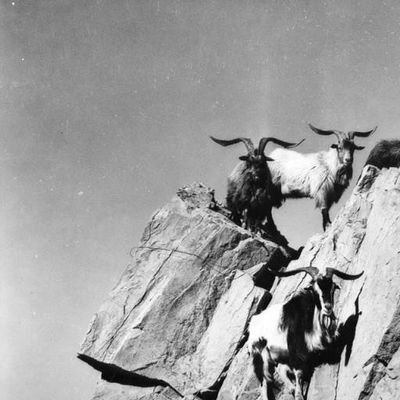2025, Bring It On. San Clemente Island Goat Projects
A rainbow of goat butts!
Every year has a spectrum of highs and lows, and maybe defining events. I have been subconsciously calling 2024 “the year of loss”. It was a year of being nimble, triaging circumstances and physical bodies, and trying to be okay not coming to terms with a damned thing. At the year's closing, I remind myself that a new year doesn’t magically wipe slates clean. But it is a marker that can be used to create intention.
To help manifest intention, I took a leap and bought a goat from Washington. Transport is already secured, and Brierwood Farm Jasper will make his home at the EB Ranch Farmstead in early January 2025.
Jasper is the offspring of a goat named EB Ranch Conan, which I sold to Brenna in WA a few years ago. Conan was the offspring of my first San Clemente Island goat buck named Max. Max, Conan, and Jasper carry a white or cream color in their genetics.
Meet Brierwood Jasper!
This ties into a project I’m working on in 2025, which is collecting genetic material, mainly semen, from a number of bucks at the farmstead. Goals and budgets are still in the early stages. I have yet to secure a veterinarian or business that will collect semen. Let alone offer insemination procedures.
The bucks in question are goats that either carry higher Tepper line %’s and or express either self-black or white-and-black color variations of the San Clemente Island goat breed. I hope this can also encompass EB Ranch Conan who now resides in Washington. The goal with semen collection is to first donate it to at least two secure locations for future needs or emergencies. Then to allow breeders to purchase semen, first to dedicated Tepper line breeders and for people who will share the offspring results if using semen from the uncommon color variations.
As I gather resources and create a budget, some local friends and supporters will help organize a fundraiser. I suspect this project will cost between $3,000-$4,000. Some of this project will also involve a “pay it forward” program making semen available for cheap or free to certain breeders. Collecting semen will not only safeguard these genetics, but make them more widely available to breeders nationwide.
A photo of three very different looking goats on the Santa Catalina Island. Goats from the Santa Catalina Island were brought to the San Clemente Island. There are currently just a few Santa Catalina Island goats left. The SCIGBA is thankful that testing has been done to find that Catalina and Clemente Island goats are indeed related genetically.
Resource link HERE.
There are so many details to expand on with this project. And the short story is that I have seen these color traits almost become extinct due to willful ignorance. There are many studies and research that need to be done with these goats. While I have no idea if different color variations present anything valuable. But representation of how the goats were observed on the island is important. And the same goes for preserving line genetics. Lines help keep genetic diversity healthy in a breed.
If you are interested in helping with fundraising organizing, or would like to donate to this project. Look for updates as I make a budget and plans more tangible. Feel free to send me an email at ebranchllc@gmail.com if you have questions.
References on San Clemente Island goat color, pattern and line preservation are below.



